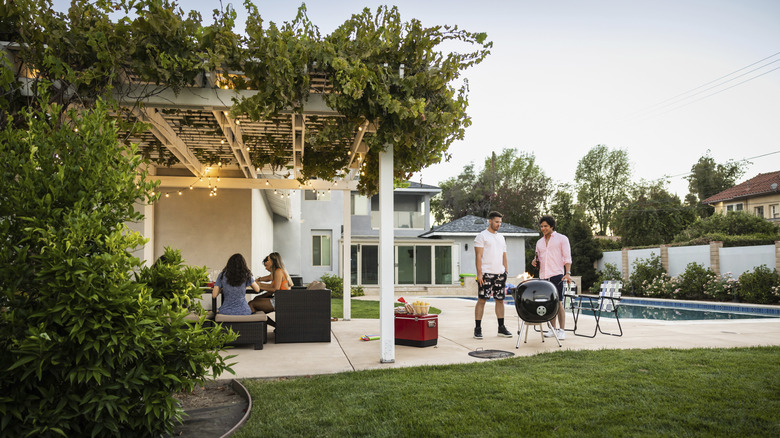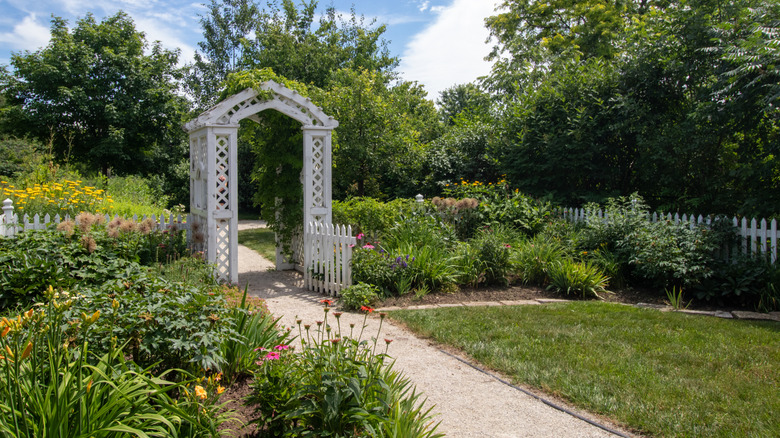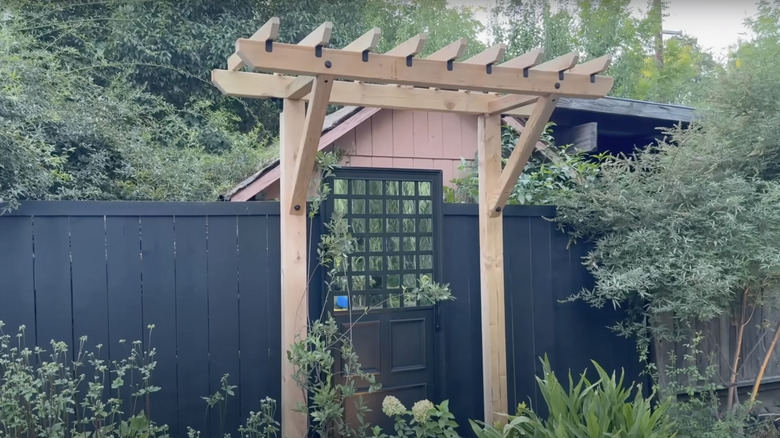The Decades-Old Garden Trend That's Making A Comeback To Replace Pergolas
Pergolas have long been the go-to structure for anyone looking to grow vines over a poolside lounge or protect an outdoor dining room from the harsh midday sun. Their sleek and minimalist design, heavy timber construction, and useful features like adjustable louvers and retractable canopies make them seem like an option worthy of investment. And that's the trouble. They're a sensible rather than passionate backyard feature. With the rise of aesthetics like cottagecore, fairycore, and bloomcore, whimsy is the look of the moment for gardens. Arbors outperform pergolas as features that turn your backyard into a secret garden oasis. Made from all kinds of materials, arbors do what pergolas do best — provide light shelter, enhance garden design, and provide somewhere for vines to climb — in a way that's decidedly more maximalist than minimalist.
Arbors typically arch over something in your garden — think pathways, seating, a gate, or even a small table and a couple of chairs — to highlight it and provide a little bit of cover from the elements. Often, an arbor functions as an entry point between separate areas of your garden, though it doesn't have to. It can also be a stopping point. It may, for example, offer a seat from which to quietly enjoy the view of the garden. Since they're almost always arching over some kind of walking area, arbors measure somewhere between 8 and 10 feet at their tallest point. They're often built from wood, but can also be made of metal or stone, or a combination of all three. Arbors can even be made of living trees trained to grow in an arch shape.
Under the arbor: What lies behind this garden trend?
While there's evidence to suggest that ancient Egyptians and Romans were familiar with arbors in their plantscapes, something more akin to the vine-covered arches of today first appeared in European Renaissance-era gardens. The structure pops up in a drawing by 16th-century Dutch artist Pieter Bruegel the Elder, suggesting an extension of the depicted castle gardens. A 17th-century engraving of a German garden shows a trellis arbor built, and plans of Dutch manors from the 1600s regularly featured arbors. In the U.S., Thomas Jefferson employed the charming landscaping feature for scarlet runner beans, arbors are mentioned at length in the 1906 book The Garden and Its Accessories by Loring Underwood, and the rose arbor at Point Defiance Park in Tacoma dates to the very early 20th century.
Today, arbors are far from the outdated landscaping trend to leave in the past that they were once considered. For one, homeowners are rejecting the neutral modernism of recent years and embracing ambiance-filled gardens — something arbors undeniably possess. Their vintage vibe provides your garden with a lived-in look; think of them as a scaled-down version of the outdoor room, which rose to prominence in recent years. What's more, they're practical. Channel picturesque Northern Italy and grow a grapevine on a weather-worn wooden arbor. Lean into the European influence and go all English cottage garden by installing an ornate wrought iron arbor over a winding stone path lined with wildflowers. Arbors also intersect with the emerging trend of arborsculpture, where trees are trained into arching shelters, among other shapes.
How to employ an arbor in your garden
Define a vegetable garden with an arbor supporting climbing edibles like squash or cucumbers, or train apple trees to grow into an arch. Situate a metal arbor — or a series of arbors — over a path and plant it with something low maintenance to reduce trimming, or treat it as a centerpiece and adorn it with romantic rambling roses or a scented clematis. Build a wooden arbor over a fence-mounted garden mirror and door — visitors will believe there's a secret garden behind it. Create a hummingbird arbor covered in nectar-filled flowering vines or repeat architectural features from your home to match it to your existing outdoor aesthetic, from roof and trim color to porch railing patterns.
What you need to build a garden arbor that doesn't break the bank can be as simple as found objects or trimmed branches. To make an arbor from raw cedar branches, drive four to six vertical posts about 3 feet into the ground and support them with horizontal beams, or weave willowy sticks you foraged for free into an arch. Building a roofed arbor from timber planks and trellis panels is the most traditional option for those with tools on hand. Anchor it to the ground using screws (if your pathway has wooden borders or steps) or by sinking it into the soil. If you want something long-lasting, curved metal piping is also an option. If you're not much of a carpenter, buy your arch. This 7-foot-tall Yaheetech Wooden Garden Arbor Climbing Arbor costs about $126.


